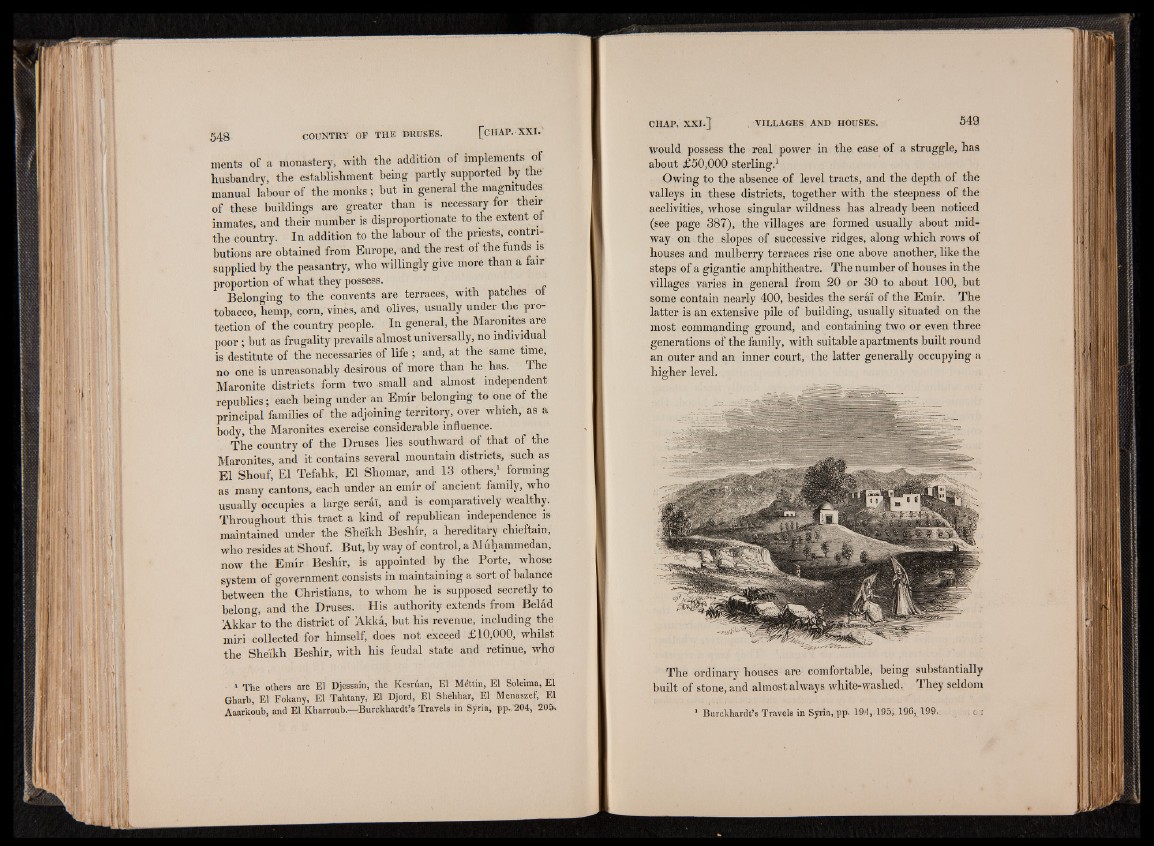
ments of a monastery, with the addition of implements, of
husbandry, the establishment being partly supported by the
manual labour of the monks ; but in general the magnitudes
of these buildings are greater than is necessary for their
inmates, and their number is disproportionate to the extent oi
the country. In addition to the labour of the priests, contributions
are obtained from Europe, and the rest of the funds is
supplied by the peasantry, who willingly give more than a fair
proportion of what they possess. p
Belonging to the convents are terraces, with patches oi
tobacco, hemp, corn, vines, and olives, usually under the protection
of the country people. In general, the Maronites are
poor; but as frugality prevails almost universally, no individual
is destitute of the necessaries of life ; and, at the same time,
no one is unreasonably desirous of more than he has. The
Maronite districts form two small and almost independent
republics; each being under an Emir belonging to one of the
principal families of the adjoining territory, over which, as a
body, the Maronites exercise considerable influence.
The country of the Druses lies southward of that of the
Maronites, and it contains several mountain districts, such as
El Shouf, El Tefahk, El Shomar, and 13 others,1 forming
as many cantons, each under an emir of ancient family, who
usually'occupies a large serai, and is comparatively wealthy.
Throughout this tract a kind of republican independence is
maintained under the Sheikh Beshir, a hereditary chieftain,
who resides at Shouf. But, by way of control, a Muhammedan,
now the Emir Beshir, is appointed by the Porte, whose
system of government consists in maintaining a sort of balance
between the Christians, to whom he is supposed secretly to
belong, and the Druses. His authority extends from Belad
Akkar to the district of Akka, but his revenue, including the
miri collected for himself, does not exceed £10,000, whilst
the Sheikh Beshir, with his feudal state and retinue, who
1 The others are El Djessain, the Kesriian, El Mdttin, El Soleima, El
Gharb, El Fokany, El Tahtany, El Djord, El Shelihar, El Menaszef, El
Aaarkoub, and El Kharroub.—Burckhardt’s Travels in Syria, pp.204, 205.
Would possess the real power in the case of a struggle, has
about £50,000 sterling.1
Owing to the absence of level tracts, and the depth of the
valleys in these districts, together with the steepness of the
acclivities, whose singular wildness has already been noticed
(see page 387), the villages are formed usually about midway
on the ^slopes of successive ridges, along which rows of
houses and mulberry terraces rise one above another, like the
steps of a gigantic amphitheatre. The number of houses in the
villages varies in general from 20 or 30 to about 100, but
some contain nearly 400, besides the serai of the Emir. The
latter is an extensive pile of building, usually situated on the
most commanding ground, and containing two or even three
generations of the family, with suitable apartments built round
an outer and an inner court, the latter generally occupying a
higher level.
The ordinary houses are comfortable, being substantially
built of stone, and almost always white-washed. They seldom